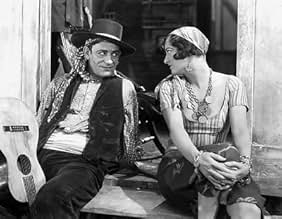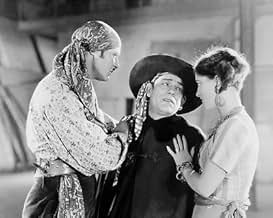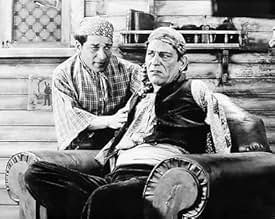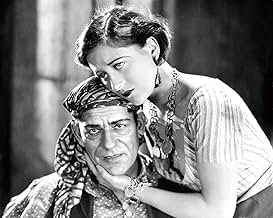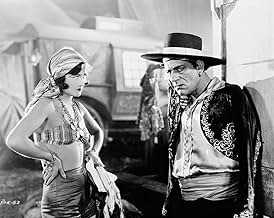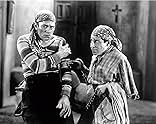AVALIAÇÃO DA IMDb
7,7/10
9,9 mil
SUA AVALIAÇÃO
Um atirador de facas, de grande sucesso num circo por não ter braços e usar os pés nos seus números, esconde um grande segredo.Um atirador de facas, de grande sucesso num circo por não ter braços e usar os pés nos seus números, esconde um grande segredo.Um atirador de facas, de grande sucesso num circo por não ter braços e usar os pés nos seus números, esconde um grande segredo.
- Direção
- Roteiristas
- Artistas
- Prêmios
- 2 vitórias e 2 indicações no total
Tom Amandares
- Gypsy running to Zanzis Death Scene
- (não creditado)
Margaret Bert
- Fortune Teller
- (não creditado)
Louise Emmons
- Gypsy Woman
- (não creditado)
Italia Frandi
- Girl in Audience Flirting with Malabar
- (não creditado)
Venezia Frandi
- Woman in Audience
- (não creditado)
Polly Moran
- Landlady
- (não creditado)
- …
Julian Rivero
- Man in Theatre Audience
- (não creditado)
Billy Seay
- The Little Wolf
- (não creditado)
Dorothy Seay
- Spectator
- (não creditado)
John St. Polis
- Surgeon
- (não creditado)
- Direção
- Roteiristas
- Elenco e equipe completos
- Produção, bilheteria e muito mais no IMDbPro
Avaliações em destaque
This movie survives with about ten minutes missing, mainly the story of Alonzo (Lon Chaney) the criminal before he hides at a circus as "Alonzo The Armless" where he uses his feet to accurately throw knives at Nanon (Joan Crawford) without hitting her. He has his actual arms strapped to his sides, making himself appear armless, thus deceiving all except his confederate Cojo, who helps Alonzo in and out of his restraining outfit at night. Alonzo involves himself in this elaborate subterfuge because he is known to have two thumbs on one hand. If that hand was seen he'd be instantly identified as the murderer that he is. He falls in love with Nanon, and she conveniently can't stand to have a man's arms around her. She feels safe around Alonzo because of his "armless" state, and only considers Alonzo a friend, but then he has never disclosed his feelings to her.
When the circus strongman, Malabar, falls in love with Nanon, suddenly Alonzo has a competitor. One day, alone in his room, ruminating over the possibility that he could lose Nanon to the strongman, Alonzo absent mindedly lights a cigarette with his feet, even with his hands freed. Suddenly, Alonzo comes up with a horrible solution to his dilemma, one that would allow him to marry Nanon and not be forced to disclose his true identity.
So many unknowns, some likely explained in the missing footage. Where did Cojo, the dwarf, who assists Alonzo come from? Was he an accomplice in Alonzo's past crimes? Why does he stick around? Why did Nanon fear having a man's hands on her? How is it that Alonzo conveniently knows the criminal past of a talented surgeon who can give him what he wants? And, most importantly of all, why didn't Alonzo just have that double thumb amputated in the beginning rather than get involved in this complex plan that culminates in such a rash solution? I guess because we'd have no movie.
Even in its abbreviated state, this early example of body horror is worthwhile and completely creepy. Plus I've found that anything Lon Chaney stars in is interesting. Joan Crawford is only third billed at this point, with Norman Kerry as Malabar getting second billing. Kerry was one of the many casualties of the transition to sound film due to his thick accent.
When the circus strongman, Malabar, falls in love with Nanon, suddenly Alonzo has a competitor. One day, alone in his room, ruminating over the possibility that he could lose Nanon to the strongman, Alonzo absent mindedly lights a cigarette with his feet, even with his hands freed. Suddenly, Alonzo comes up with a horrible solution to his dilemma, one that would allow him to marry Nanon and not be forced to disclose his true identity.
So many unknowns, some likely explained in the missing footage. Where did Cojo, the dwarf, who assists Alonzo come from? Was he an accomplice in Alonzo's past crimes? Why does he stick around? Why did Nanon fear having a man's hands on her? How is it that Alonzo conveniently knows the criminal past of a talented surgeon who can give him what he wants? And, most importantly of all, why didn't Alonzo just have that double thumb amputated in the beginning rather than get involved in this complex plan that culminates in such a rash solution? I guess because we'd have no movie.
Even in its abbreviated state, this early example of body horror is worthwhile and completely creepy. Plus I've found that anything Lon Chaney stars in is interesting. Joan Crawford is only third billed at this point, with Norman Kerry as Malabar getting second billing. Kerry was one of the many casualties of the transition to sound film due to his thick accent.
The Unknown (1927)
We can see The Unknown today and say, wow, look at the young Joan Crawford. And she does help make this movie come alive, more than even Lon Chaney, who was the big draw for audiences in 1927. Crawford's spark (inspired by Chaney, by her own account), and her character's phobia of men's hands (which she explains quite reasonably, having been groped too many times against her will) make her curious and very sympathetic. She's terrific to watch, and the metaphor of abuse against women is not lost on anyone paying attention.
But Crawford was essentially unknown back then, and the movie depended on the name, and the high dramatics, of Chaney and the other lead male, the charming, somewhat overly chipper strong man in this huge sideshow of a movie. Both are good enough in their roles, Chaney pulling out all the stops in a performance that might be bravura or might just be virtuosic indulgence, probably a bit of both.
And the movie depends on the story itself, the plot, the strange and gruesome series of events, which are gripping at times even if you know what's coming all too well. For viewers then as much as now, there is also the whole milieu, director Tod Browning's leaning to the macabre and the small time circus. This will see a more amazing fruition five years alter in Freaks, shortly after his very successful Dracula (with its self-sustaining sideshow of bizarre, legendary types). But here we have Browning at the end of the silent era, pushing gestures and expressions outward in the place of sound. It's a bit strained, and with the sensational plot, the whole movie lacks subtlety and depth.
What it doesn't lack is high drama, though, and a few surprises. At times touching, at times simply shocking (in its own way), it's enjoyable, and never really flags, which some "better" silent films like Broken Blossoms can't claim. So forget beauty, or elegance or emotional insight and you might really like this.
Oh, and Chaney? He is a marvel of his time, and this film shows him in one of his best roles as an actor, one of many. The armless man is yet another echo of the horrors of mutilated soldiers coming home from World War I and their inability to really assimilate and be accepted. The fact that his character is obsessed with Crawford's we might understand, but it's a love that we don't sympathize with after awhile.
We can see The Unknown today and say, wow, look at the young Joan Crawford. And she does help make this movie come alive, more than even Lon Chaney, who was the big draw for audiences in 1927. Crawford's spark (inspired by Chaney, by her own account), and her character's phobia of men's hands (which she explains quite reasonably, having been groped too many times against her will) make her curious and very sympathetic. She's terrific to watch, and the metaphor of abuse against women is not lost on anyone paying attention.
But Crawford was essentially unknown back then, and the movie depended on the name, and the high dramatics, of Chaney and the other lead male, the charming, somewhat overly chipper strong man in this huge sideshow of a movie. Both are good enough in their roles, Chaney pulling out all the stops in a performance that might be bravura or might just be virtuosic indulgence, probably a bit of both.
And the movie depends on the story itself, the plot, the strange and gruesome series of events, which are gripping at times even if you know what's coming all too well. For viewers then as much as now, there is also the whole milieu, director Tod Browning's leaning to the macabre and the small time circus. This will see a more amazing fruition five years alter in Freaks, shortly after his very successful Dracula (with its self-sustaining sideshow of bizarre, legendary types). But here we have Browning at the end of the silent era, pushing gestures and expressions outward in the place of sound. It's a bit strained, and with the sensational plot, the whole movie lacks subtlety and depth.
What it doesn't lack is high drama, though, and a few surprises. At times touching, at times simply shocking (in its own way), it's enjoyable, and never really flags, which some "better" silent films like Broken Blossoms can't claim. So forget beauty, or elegance or emotional insight and you might really like this.
Oh, and Chaney? He is a marvel of his time, and this film shows him in one of his best roles as an actor, one of many. The armless man is yet another echo of the horrors of mutilated soldiers coming home from World War I and their inability to really assimilate and be accepted. The fact that his character is obsessed with Crawford's we might understand, but it's a love that we don't sympathize with after awhile.
One of the strong points of silent movies is that they are naive in the positive meaning of the word: they are creative.
If anyone does a story like that today, one has to choose to do a drama, a thriller or a black comedy. Browning did not have to choose... he just made a very strange film.
Another plus is the use of running time. No fillers. Just 60 minutes of strange ideas. The film is not perfect; and not anyone will enjoy it. But it features a great performance by Lon Chaney and nice photography (incl. creative use of backprojection). And if you like FREAKS, you have to see this one... the background of Browning as a circus assistant really shows up (though I hope, it wasn't that bad).
Sorry, no story details. I don't want to ruin your fun.
If anyone does a story like that today, one has to choose to do a drama, a thriller or a black comedy. Browning did not have to choose... he just made a very strange film.
Another plus is the use of running time. No fillers. Just 60 minutes of strange ideas. The film is not perfect; and not anyone will enjoy it. But it features a great performance by Lon Chaney and nice photography (incl. creative use of backprojection). And if you like FREAKS, you have to see this one... the background of Browning as a circus assistant really shows up (though I hope, it wasn't that bad).
Sorry, no story details. I don't want to ruin your fun.
A circus performer ventures into THE UNKNOWN regions of fate when he allows love to be twisted by hatred.
Master actor Lon Chaney and his friend, acclaimed director Tod Browning, took their love of the macabre and fashioned this weirdly entertaining & suspenseful little silent film, made wonderful by Chaney's powerful over-the-top performance. Playing the armless wonder in a gypsy circus, Chaney's face is a casebook of emotions as he longs for the chieftain's daughter. After making a tremendous, indeed, outrageous, sacrifice for her, he discovers it is all an utter waste. Chaney's agony is horribly apparent as he feels his life crumble around him. The actor uses his superb physical conditioning to great effect, his feet as facile as any hands--the extreme punishment undergone to play the part enormously impressive.
In an important early film role, Joan Crawford is both sultry & disarming as the object of Chaney's desires; her intense neurotic phobia concerning men's hands certainly makes her character more interesting. Norman Kerry is affable & tender as the circus strong man who also loves Crawford. John George as Chaney's dwarf accomplice and Nick De Ruiz as the brutal circus chief are quite effective in their colorful roles.
MGM gave the film fine production values, especially in the circus scenes--a milieu dear to Chaney's heart.
Master actor Lon Chaney and his friend, acclaimed director Tod Browning, took their love of the macabre and fashioned this weirdly entertaining & suspenseful little silent film, made wonderful by Chaney's powerful over-the-top performance. Playing the armless wonder in a gypsy circus, Chaney's face is a casebook of emotions as he longs for the chieftain's daughter. After making a tremendous, indeed, outrageous, sacrifice for her, he discovers it is all an utter waste. Chaney's agony is horribly apparent as he feels his life crumble around him. The actor uses his superb physical conditioning to great effect, his feet as facile as any hands--the extreme punishment undergone to play the part enormously impressive.
In an important early film role, Joan Crawford is both sultry & disarming as the object of Chaney's desires; her intense neurotic phobia concerning men's hands certainly makes her character more interesting. Norman Kerry is affable & tender as the circus strong man who also loves Crawford. John George as Chaney's dwarf accomplice and Nick De Ruiz as the brutal circus chief are quite effective in their colorful roles.
MGM gave the film fine production values, especially in the circus scenes--a milieu dear to Chaney's heart.
The Unknown is one of the more interesting Lon Chaney collaborations with director/writer Tod Browning, as Chaney's typically physically malleable performance is often executed here in conjunction with "stunt double" Peter Dismuki. It also features a great, early appearance by Joan Crawford, a complex, gripping, allegorically deep but economically told story by Browning, and it is an excellent instantiation of themes found throughout Chaney and Browning's other work. It even strongly presages Browning's 1932 film, Freaks.
Chaney is Alonzo the Armless, a performer in Antonio Zanzi's circus. Alonzo is in love with Nanon (Crawford), Antonio's daughter and Alonzo's assistant in his act, which consists of him using his feet to shoot guns and throw knives around Nanon with precision aim. In a typical Chaney film complicated love triangle, Nanon and Zanzi Circus strongman Malabar are also attracted to each other, but Nanon has an aversion to being touched and keeps distancing Malabar and any other man who wants to be intimate.
Alonzo is the perfect complement for Nanon then, since he cannot manhandle her. She feels safe with him. But Antonio objects to Alonzo's approaches towards Nanon. Complex confrontations and a number of fabulous twists ensue, and Chaney fans will likely expect the resultant profound tragedy with the reciprocally bittersweet "happy ending" consequences.
I probably made that synopsis sound more soap-operatic than it should, since it doesn't very well convey the overall twisted, creepy atmosphere that Browning achieves in The Unknown. Like Freaks, this isn't exactly a horror film, but it has all the unsettling, macabre attitude of one. Alonzo is one of Chaney's more demented, sinister characters, as almost every move he makes has a nefarious, ulterior motive. This even includes the reason that he joined the Zanzi Circus in the first place. It becomes quickly clear that Alonzo will stop at nothing to have Nanon all to himself. But because the character has no arms, he can't very well resort to physical bullying. Instead, Chaney paints a subversive and deviously manipulative character. Even the character's love for Nanon feels wicked--it's more of an unhealthy obsession than love.
Browning makes good use of his largely pared down sets and cast. Except for the opening circus scene, most of the film takes place among only four characters, in only a handful of circus wagon (used later for both Freaks and Chaney's 1928 film Laugh, Clown, Laugh) and apartment locations, with the ending, set in a theater, symmetrically reflecting the opening of the film. A single scene in a formal courtyard provides a nice, symbolic contrast, as does the use of the "extended technique" of a thin piece of gauze placed over the camera lens for some of Nanon's scenes.
Equally economical is Browning's complex story, which tells as much--with the aid of the performances--through implication of various backstories as it does through direct action. The (heavily allegorical) subtexts are fascinating. Nanon is frigid, so her most intimate relationship is with a man who has been effectively castrated. He is so obsessed with her that he'll physically sacrifice himself to enable a relationship. She secretly desires a normal love, but can't have one until she falls into it, or is tricked into it in a way. No one is quite honest with anyone else except for a man who is a relative simpleton, there to be manipulated. But he's the one who ends up coming out ahead, even though he never quite knows what is going on.
Browning had to construct a number of elaborate set-ups to produce the illusion that Chaney had been using his feet to do everyday activities for a long time. We often see Chaney's body but Peter Dismuki's feet, such as when Alonzo is playing guitar, smoking, drinking, and so on. Occasionally, Dismuki just stood in for Chaney, usually when Alonzo has his back to the camera, but at least in one wider shot, we can see Dismuki's face.
The 1997 score on the Turner Classic Movies version of the film by the Alloy Orchestra is occasionally excellent--especially during the climax of the film, and occasionally a bit pedestrian. When it's only pedestrian it's at least unobtrusive. The score has a modern, occasionally "rocky" feel that meshes surprisingly well.
There are a few scenes missing from the print transferred to the TCM DVD, but for many years, The Unknown was thought to have been lost, similar to Browning and Chaney's 1927 film London After Midnight. A print was found at the Cinémathèque Française, mixed in with a lot of other films marked "unknown" because the contents were (at least temporally) unidentifiable. The missing scenes do not hurt the coherency of the film, which is a must-see at least for any Chaney or Browning fans.
Chaney is Alonzo the Armless, a performer in Antonio Zanzi's circus. Alonzo is in love with Nanon (Crawford), Antonio's daughter and Alonzo's assistant in his act, which consists of him using his feet to shoot guns and throw knives around Nanon with precision aim. In a typical Chaney film complicated love triangle, Nanon and Zanzi Circus strongman Malabar are also attracted to each other, but Nanon has an aversion to being touched and keeps distancing Malabar and any other man who wants to be intimate.
Alonzo is the perfect complement for Nanon then, since he cannot manhandle her. She feels safe with him. But Antonio objects to Alonzo's approaches towards Nanon. Complex confrontations and a number of fabulous twists ensue, and Chaney fans will likely expect the resultant profound tragedy with the reciprocally bittersweet "happy ending" consequences.
I probably made that synopsis sound more soap-operatic than it should, since it doesn't very well convey the overall twisted, creepy atmosphere that Browning achieves in The Unknown. Like Freaks, this isn't exactly a horror film, but it has all the unsettling, macabre attitude of one. Alonzo is one of Chaney's more demented, sinister characters, as almost every move he makes has a nefarious, ulterior motive. This even includes the reason that he joined the Zanzi Circus in the first place. It becomes quickly clear that Alonzo will stop at nothing to have Nanon all to himself. But because the character has no arms, he can't very well resort to physical bullying. Instead, Chaney paints a subversive and deviously manipulative character. Even the character's love for Nanon feels wicked--it's more of an unhealthy obsession than love.
Browning makes good use of his largely pared down sets and cast. Except for the opening circus scene, most of the film takes place among only four characters, in only a handful of circus wagon (used later for both Freaks and Chaney's 1928 film Laugh, Clown, Laugh) and apartment locations, with the ending, set in a theater, symmetrically reflecting the opening of the film. A single scene in a formal courtyard provides a nice, symbolic contrast, as does the use of the "extended technique" of a thin piece of gauze placed over the camera lens for some of Nanon's scenes.
Equally economical is Browning's complex story, which tells as much--with the aid of the performances--through implication of various backstories as it does through direct action. The (heavily allegorical) subtexts are fascinating. Nanon is frigid, so her most intimate relationship is with a man who has been effectively castrated. He is so obsessed with her that he'll physically sacrifice himself to enable a relationship. She secretly desires a normal love, but can't have one until she falls into it, or is tricked into it in a way. No one is quite honest with anyone else except for a man who is a relative simpleton, there to be manipulated. But he's the one who ends up coming out ahead, even though he never quite knows what is going on.
Browning had to construct a number of elaborate set-ups to produce the illusion that Chaney had been using his feet to do everyday activities for a long time. We often see Chaney's body but Peter Dismuki's feet, such as when Alonzo is playing guitar, smoking, drinking, and so on. Occasionally, Dismuki just stood in for Chaney, usually when Alonzo has his back to the camera, but at least in one wider shot, we can see Dismuki's face.
The 1997 score on the Turner Classic Movies version of the film by the Alloy Orchestra is occasionally excellent--especially during the climax of the film, and occasionally a bit pedestrian. When it's only pedestrian it's at least unobtrusive. The score has a modern, occasionally "rocky" feel that meshes surprisingly well.
There are a few scenes missing from the print transferred to the TCM DVD, but for many years, The Unknown was thought to have been lost, similar to Browning and Chaney's 1927 film London After Midnight. A print was found at the Cinémathèque Française, mixed in with a lot of other films marked "unknown" because the contents were (at least temporally) unidentifiable. The missing scenes do not hurt the coherency of the film, which is a must-see at least for any Chaney or Browning fans.
Você sabia?
- CuriosidadesJoan Crawford always considered "O Monstro do Circo (1927)" a big turning point for her. She said it wasn't until working with Lon Chaney in this film that she learned the difference between standing in front of a camera and acting in front of a camera. She said that was all due to Chaney and his intense concentration, and after that experience she said she worked much harder to become a better actress.
Chaney's performance certainly inspired co-star Crawford who wrote "Lon Chaney was my introduction to acting. The concentration, the complete absorption he gave to his characterization filled me with such awe I could scarcely speak to him...watching him have me the desire to be a real actress."
- Erros de gravaçãoMalabar pushes himself up off the bureau multiple times when talking to Nanon about flowers.
- Citações
Malabar the Mighty, Circus Strongman: There is a time for fear, Nanon... and a time for hate... and a time for love.
- Versões alternativasThe Turner library print has a commissioned score by the Alloy Orchestra and runs 49 minutes.
- ConexõesFeatured in Terror Universal (1998)
Principais escolhas
Faça login para avaliar e ver a lista de recomendações personalizadas
- How long is The Unknown?Fornecido pela Alexa
Detalhes
- Data de lançamento
- País de origem
- Idiomas
- Também conhecido como
- The Unknown
- Locações de filme
- Empresa de produção
- Consulte mais créditos da empresa na IMDbPro
Bilheteria
- Orçamento
- US$ 217.000 (estimativa)
- Faturamento bruto mundial
- US$ 4.841
- Tempo de duração1 hora 8 minutos
- Cor
- Mixagem de som
- Proporção
- 1.33 : 1
Contribua para esta página
Sugerir uma alteração ou adicionar conteúdo ausente

Principal brecha
By what name was O Monstro do Circo (1927) officially released in India in English?
Responda
